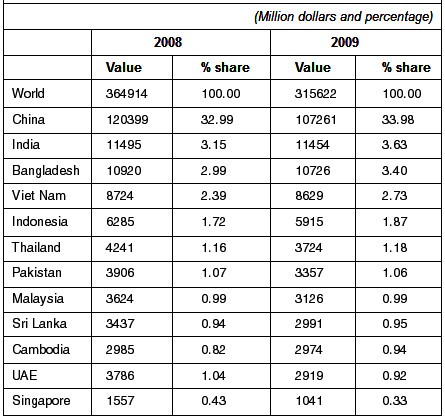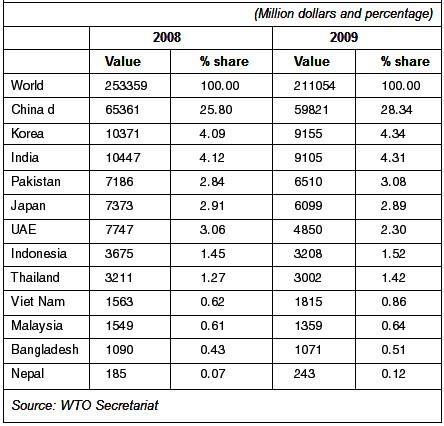Following information was given by Smt.Panabaaka Lakshmi, Minister of State for Textiles in written reply to a question in Lok Sabha on May 31, 2012.
The financial stress of the textile industry has a negative impact on the banking system, as banks have lent fund based credit of Rs. 155809 crores. The textile sector constitutes 8% (at the end of third quarter of financial year 2011) of the total restructured assets across banks. In addition, it constitutes Rs. 11370 crores of the total quantum of loans under the CDR mechanism.Duty drawback rates are determined by Government every year based on recommendation of the the All India Duty Drawback Committee. The drawback rates of China, Pakistan and Bangladesh are not compiled by Government.
Indian Textiles mills have access to the cheapest cotton in the world. India is relatively cost competitive in terms of material cost for products that use domestically manufactured fabric. In both Men’s cotton Chinos and cotton T-Shirts it has the second lowest material costs per garment when fabric, cotton, trims, labels and packaging material are sourced locally. For men’s Chino’s India’s material cost per garment is $ 4.119, next only to Pakistan ($4.016) and 7% cheaper than China, 11% cheaper than Bangladesh, and 13% lower than Cambodia. For cotton knit T-shirts, India’s material cost per garment ($ 0.87) is 9% lower than China, 10% lower than Bangladesh and Cambodia, and 4% higher than Pakistan.
The details of clothing and textile exports value alongwith markets share of leading Asian textile producing countries as well as of India during 2008 and 2009 are given in Table 1 and 2 respectively.
In order to strengthen export of textile items including apparel and garments and get higher market share in America and European countries, the Government has granted incentives under various provisions of the Foreign Trade Policy 2009-14. This includes incentives for exports to focus markets and exports of focus products, extension Duty Entitlement Pass book Scheme; interest subvention on pre-shipment credit, duty free import of trimmings etc. required by garmenting industry and duty free import of tools by the handicraft industry.
This apart, financial assistance is being provided to the exporters under the Market Development Assistance Scheme and the Market Access Initiative Scheme for enhancing share in existing markets and for exploring new markets. Steps taken by Government to improve the textiles export during the next year include easing infrastructural bottlenecks for export promotion, improving competitiveness of Indian textiles export, region specific approaches for export promotion and creating facilities for social and environmental compliance for the exports sector.







